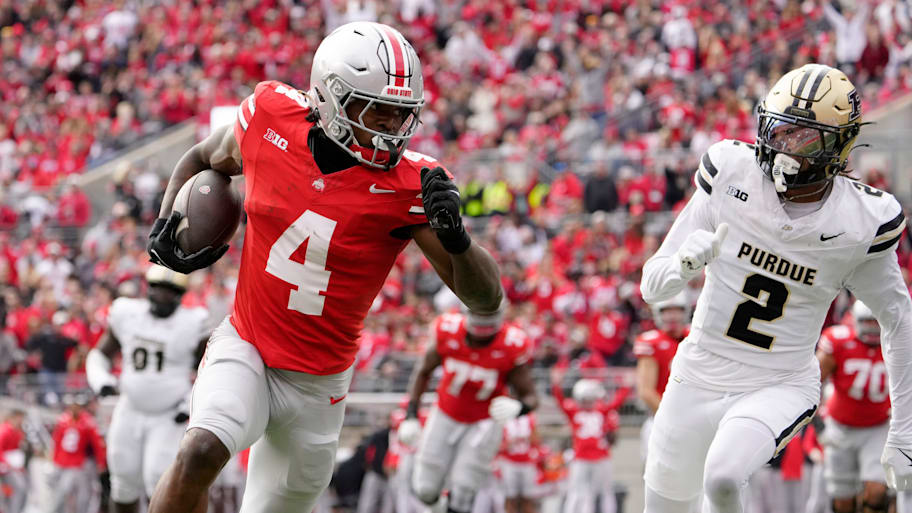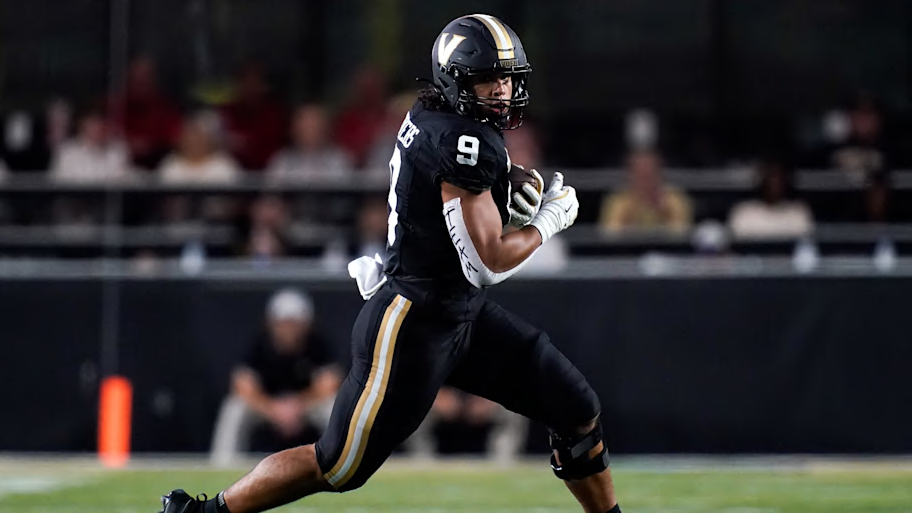
Back by popular demand (or force of habit), it’s the college football Most Intriguing Lists. First up: coaches. Next up: quarterbacks. Now: non-quarterbacks:
1. Jeremiah Smith, WR, Ohio State
Marvin Harrison Jr. didn’t have a freshman season like Smith. Neither did DeVonta Smith at Alabama. Or any of the LSU star receivers from the past decade. The only true freshman of the last 25 years whose freshman year rivals Smith’s instant-impact domination was Oklahoma running back Adrian Peterson in 2004—and his team didn’t win the national title. Smith’s did, and he clinched it with a 56-yard catch against Notre Dame. After 76 catches for 1,315 yards and 15 touchdowns, it’s almost unfair that the 6' 3", 215-pound specimen has to play two more seasons of college football. But Ohio State fans are deliriously happy that he does.
2. Jeremiyah Love, RB, Notre Dame
Arguably, the two most memorable runs of the College Football playoff were by Love: the first went 98 yards four minutes into the inaugural on-campus playoff game, against Indiana; the second covered just two yards for an epic willpower touchdown against Penn State in the playoff semifinals. Blazing speed (four runs of 60 yards or longer last season) and sheer determination are a nice combination for a back to have. Love was kept on a tight pitch count last season by offensive coordinator Mike Denbrock, with 191 scrimmage touches in 16 games. Without high-usage QB Riley Leonard, his workload should increase. If so, his Heisman Trophy chances will rise accordingly.
3. Kadyn Proctor, OT, Alabama
He might be the world’s largest cologne fanatic. Proctor says he owns roughly 170 bottles of the stuff, applying it frequently to keep his 6' 7", 360-pound self smelling fresh. “If you’re a big guy, you can’t stink,” he said in July. “You’ve got to be fresh, man … Got to flip the narrative.” The other narrative Proctor would probably like to flip is the one that paints him as a villain in his home state of Iowa. He was committed to the Hawkeyes until national signing day in December 2022, flipping to the Crimson Tide. Then, when Nick Saban retired, Proctor transferred to Iowa, only to double back to Tuscaloosa, Ala., three months later. The double spurning of the Hawkeyes has fomented some bitterness.
4. David Bailey, DE, Texas Tech
Bailey is the face of the Red Raiders’ portal payroll push toward relevance, having been handsomely compensated to transfer to Tech from Stanford. The quarter system at Stanford allowed him to transfer into Tech midway through spring practice, which should mitigate on-field transition issues. (Going from Palo Alto, Calif., to Lubbock is another thing entirely off the field.) Bailey was fourth nationally in forced fumbles last season with five, and has totaled 14.5 sacks and 22.5 tackles for loss in his three-year college career. He’s expected to immediately upgrade a pass rush that ranked in the bottom half of the Big 12 in sacks last year.
5. Koi Perich, DB/WR, Minnesota
He wears a half-maroon, half-white jersey in practice, a P.J. Fleck idea (of course) that signifies his two-way status as both a defensive back and wide receiver. Travis Hunter 2.0? Maybe this is the starter set. The four-star recruit who turned down more accomplished programs had a spectacular freshman season, recording 46 tackles, five interceptions, a forced fumble and serving as the Gophers’ primary kick returner. This year, he will add some snaps on offense. A video clip from early August practice of Perich catching a deep ball whetted the appetites of Minnesota fans who saw just six completions of 30 yards or longer last season. “If he had it his way, he would never come off the field,” Fleck said.
6. Nick Singleton and Kaytron Allen, RBs, Penn State
They’ve shared the ball and the backfield for three seasons in Happy Valley, why not one more? Singleton and Allen have been an inseparable one-two punch in the Nittany Lions’ offense, combining for 1,047 carries, 130 receptions, 5,789 rushing yards, 1,090 receiving yards and 69 total touchdowns. Naturally, they both announced on the same day—less than a week after the season-ending loss to Notre Dame—that they would stay at Penn State for their senior seasons. Both were considered top-10 draft prospects among running backs, and their decisions were instrumental in solidifying Penn State’s veteran nucleus for a potential national title run this season.
7. Parker Kingston, WR/KR, BYU
Is there another returning collegian who has scored multiple touchdowns receiving, returning kicks and passing? Kingston has, with a pair of punt-return TDs last year, three TD passes over the past two seasons and a couple of receiving scores. His touchdown plays have tended to be spectacular: a wild, 90-yard punt return against Kansas State; a 64-yard punt runback in the Alamo Bowl against Colorado; a 20-yard receiving score and a 33-yard passing TD against Arizona; a 20-yard reception and a 37-yard passing touchdown against Arkansas in 2023; and a 26-yard TD pass against Iowa State that year as well. Kingston also says he’s the best golfer on the BYU team, with a 5-handicap.
8. Archie Wilson, P, Nebraska
For a guy who has never played a game of American college football, the intrigue is immense with Wilson. There have been a ton of Australian import punters over the years, but how about one who is ambipedal? That’s right, he can kick with either foot, thus adding an element of uncertainty for the return team. (As a rugby-style punter, Wilson could roll out in either direction to kick the ball.) “He’s, like, the most interesting man in the world to me,” Nebraska coach Matt Rhule said. Wilson went from a curiosity to an endearing teenager dealing with some homesickness this week, when he responded to a question about his family back home by breaking into tears. Who won’t be wishing the best for this kid?
9. Peter Woods, DT, Clemson
Dabo Swinney wooed Woods out of Alabama in 2023 after he led his high school to four state championships. He’s now the linchpin of a defense being compared to the Clemson units from 2017 to ’19 that were led by freak linemen and ranked in the top three nationally in points allowed per game. At 6' 3", 315 pounds, Woods has the mass of a run stopper but the athleticism to do more than just inhale blockers—he gets into the backfield, as his 8.5 tackles for loss in 11 games last season showed. Woods has seen action as a blocking fullback in short-yardage jumbo personnel packages; does he get to run the ball this season?
10. Harold Perkins Jr., LB, LSU
As a freshman in 2022, he appeared to be the next Will Anderson of the SEC, a game-wrecking edge rusher powered by explosive athleticism. But the career path has taken some turns since then: a moderate regression as a sophomore, as the Tigers fiddled with where to play him, and then a season-ending knee injury in the fourth game last year. Now, LSU defensive coordinator Blake Baker is plugging in Perkins as a hybrid linebacker-safety, with the intent to maximize his speed getting to the ball. The Tigers’ hopes of meeting high expectations this season largely hinge on an improved defense, and a healthy Perkins is a huge part of that.

11. Caleb Downs, S, Ohio State
It’s not a stretch to say the Buckeyes have the two best players in the nation in Smith and Downs. The latter is an ideal modern safety, capable of playing down in the box in sturdy run support, covering downfield on pass routes and showing up in the backfield as a blitzer—all in the same possession, if needed. The transfer from Alabama kept making a bigger impact as his first season at Ohio State unfolded—he returned a punt for a touchdown against Indiana, made 11 tackles against Michigan, broke up three passes in the Rose Bowl quarterfinal against Oregon, and had an interception and a tackle for loss in the semifinal against Texas.
12. Ryan Williams, WR, Alabama
He burst onto the scene as a freshman even more explosively than Smith early last season, scoring six touchdowns in his first five college games and averaging a massive 28.6 yards per catch. His debut month was capped by a balletic, 75-yard touchdown catch and run that beat Georgia in a September classic. That start was unsustainable, though, and the rest of the season was merely good (two TDs and 11.1 yards per reception over the last eight games). But as an absolute speed burner plugged into new coordinator Ryan Grubb’s vertical-stretch passing game, Williams will terrify SEC defenses this season.
13. Isaac Brown, RB, Louisville
Yet another big-play 2024 freshman who made a shockingly easy transition to college. Brown’s 7.11 yards per rush was the highest among running backs who logged at least 150 carries, showcasing an advanced arsenal of moves to go along with dazzling speed. The Homestead, Fla., product had five 100-yard games despite averaging only 12.7 carries per game. At 5' 9" and 170 pounds, he’s still probably not equipped to be a 20-carry-a-game guy, but he should get more touches while still making room in a big-play backfield for fellow sophomore Duke Watson (597 rushing yards, seven TDs last season).
14. Jordyn Tyson, WR, Arizona State
What’s the biggest reason to believe the Sun Devils can still roll offensively after losing powerhouse running back Cam Skattebo? The pass-and-catch combination of QB Sam Leavitt and Tyson, who racked up 75 receptions for 1,101 yards and 10 touchdowns despite missing the last two games of the season with injury. Tyson averaged 8.6 receptions for 124.8 yards over his final five games, as the Sun Devils grew into a serious national contender. Despite that, Tyson might not even be the best athlete in his family—his brother, Jaylon, was the 20th pick in the first round of the 2024 NBA draft by the Cleveland Cavaliers.
15. Anthony Hill Jr., LB, Texas
Arch Manning was the Longhorns’ most-celebrated recruit of the 2023 class, but so far, Hill has been the most productive. The five-star linebacker, who flipped from Texas A&M, made an instant impact as a freshman and then blew up into a star last season as a sophomore, leading the team in tackles (113), tackles for loss (16.5) and forced fumbles (four). The 6' 3", 235-pounder is certainly big enough to pack a wallop, but also athletic enough to have been a triple jumper and relay runner on his high-school track team. Hill has been at his best in the Red River Rivalry games against Oklahoma, racking up 19 total tackles, three sacks and a forced fumble in two matchups with the Sooners.
16. Jaydn Ott, RB, Oklahoma
The Calgorithm, one of the delights of the 2024 season, took enough of a shine to Ott that he was memorialized in a Chappell Roan take-off. Just one issue with “Ott To Go”: the lyrics said Ott was “never leaving Cal, he’s finna stay.” Welp, he’s now in the Sooners’ backfield and hoping to regain the burst of his first two seasons after playing through a lingering ankle injury last year. Ott produced more than 3,300 yards from scrimmage as a Golden Bear. If he helps get Oklahoma back to prominence, they’ll write a song about him in Norman, Okla., too.
17. D’Angelo Ponds, DB, Indiana
The key to Curt Cignetti’s instant success with the Hoosiers was his importation of a dozen of his players from James Madison. None of them was more important than Ponds, an undersized (5 9", 170) cornerback who was a three-star recruit out of Miami with one power-conference offer (Syracuse). Ponds made a lot of tackles last season for a corner (55) and broke up nine passes. He also had four interceptions, including a 67-yard pick-six against Washington, and blocked a punt against Michigan State. A reason to believe Indiana can run back last year’s miracle: the defense returns its leading tackler (linebacker Aiden Fisher), leading sacker (end Mikail Kamara) and leading cover guy in Ponds.
18. Eli Stowers, TE, Vanderbilt
As recently as 2023, Stowers was a quarterback. Now he’s an NFL prospect tight end. Diego Pavia wasn’t the only important transfer from New Mexico State last year, with Stowers coming along as well. His role with the Aggies in ’23 evolved from backup QB to impact receiver, making 35 catches for 366 yards in the final 10 games of that season. Last year at Vandy, Stowers was Pavia’s No. 1 target, making 49 receptions for 638 yards and five touchdowns. That included a 113-yard game in the upset of Alabama that changed the tenor of the Vanderbilt season—and, perhaps, the entire program, depending how this year goes.

19. Bryson Washington, RB, Baylor
The Bears were 2–4 midway through last season, and coach Dave Aranda looked like a goner. That’s about when he started giving Washington the danged ball, turning around the season. After not playing in the first two games and averaging 11.8 carries over the next four, Washington’s workload jumped to 21.2 carries and 136.3 yards over the final half of the regular season—and Baylor won all those games. That included consecutive four-touchdown games against TCU and West Virginia. Aranda earned another season, in no small part because Washington came to the rescue of the running game.
20. Dillon Thieneman, DB, Oregon
In two seasons at Purdue, Thieneman recorded 210 tackles, six interceptions and two forced fumbles—often serving as the last line of defense in an overwhelmed unit during the dismal Ryan Walters era. Purdue was in the Carmel, Ind., product’s blood, following older brothers Jake and Brennan to West Lafayette, Ind., to play safety, but it was time to go after last year. Thieneman was a hot commodity on the transfer market, and Oregon won out for his services. He could be one more productive season away from being selected in the first or second round of the NFL draft.
21. Desmond Reid, RB/KR, Pittsburgh
Reid was a standout in the FCS Southern Conference at Western Carolina, and his multifaceted game translated quickly and easily last year to Pitt and the ACC. Undersized at a listed 5' 8" and 175 pounds, Reid was a versatile weapon for the Panthers. He scored five touchdowns rushing, four receiving and one on a punt return while averaging 154.9 all-purpose yards per game. Reid’s nine plays from scrimmage of 30 yards or longer trailed only North Carolina’s Omarion Hampton in the ACC, and he was second in the league in average punt return at 14.5 yards.
22. Red Murdock, LB, Buffalo
He’s on a never-ending mission to find the football—then take it away. Murdock forced a nation-leading seven fumbles last year, most in FBS since 2019, and was second nationally in total tackles with 156. Yet another player from Virginia (Petersburg) who was not recruited by Virginia or Virginia Tech, Murdock went through Fork Union and wound up at Buffalo, where he redshirted in 2022 and has been a tackling machine ever since. Murdock stuck it out through a 3–9 season and a coaching change, then helped first-year coach Pete Lembo to a surprising 9–4 record last year.
23. Paolo Gennarelli, OG, Army
At a school that plays violent football in the trenches and builds beasts in the weight room, Gennarelli is the meanest and strongest. He’s benched 495 pounds, squatted 605 and deadlifted 675, all program records at the time of the lifts. Army led the nation in rushing offense last year by a wide margin, and the line won the Joe Moore Award for best in the country. Gennarelli was a powerful part of it, who is now tasked with carrying their nasty demeanor into 2025. “We’re going to take names today, that was the mentality all season,” he said earlier this month.
24. Logan Jones, C, Iowa
The old guys aren’t completely rinsed out of the college football system yet, and Jones is one of them. He’s a sixth-year Hawkeye who will turn 24 around midseason, having started 39 games over the past three years at center—which was not his original position. Jones was originally a defensive lineman who moved to offense and jumped into the starting lineup after star center Tyler Linderbaum went to the NFL. Jones has the athleticism of a three-year letter winner in basketball and a four-year letter winner in track in high school. This year, he will be snapping the ball to the most talented quarterback in his six seasons at Iowa in South Dakota State transfer Mark Gronowski.
25. Ian Schieffelin, TE, Clemson
Better known as a power forward for the past four years on the Tigers’ basketball team, Schieffelin is a first-time college football player trying to follow the Antonio Gates/Jimmy Graham route as an athletic tight end. Swinney told Schieffelin he could be “playing basketball in Afghanistan” as a professional or try the football route when offering him a spot on the team. At 6' 7", 260 pounds, Schieffelin has plenty of size—we’ll see whether he has an appetite for the game.
More College Football on Sports Illustrated
This article was originally published on www.si.com as The 25 Most Intriguing College Football Non-Quarterbacks for 2025.







